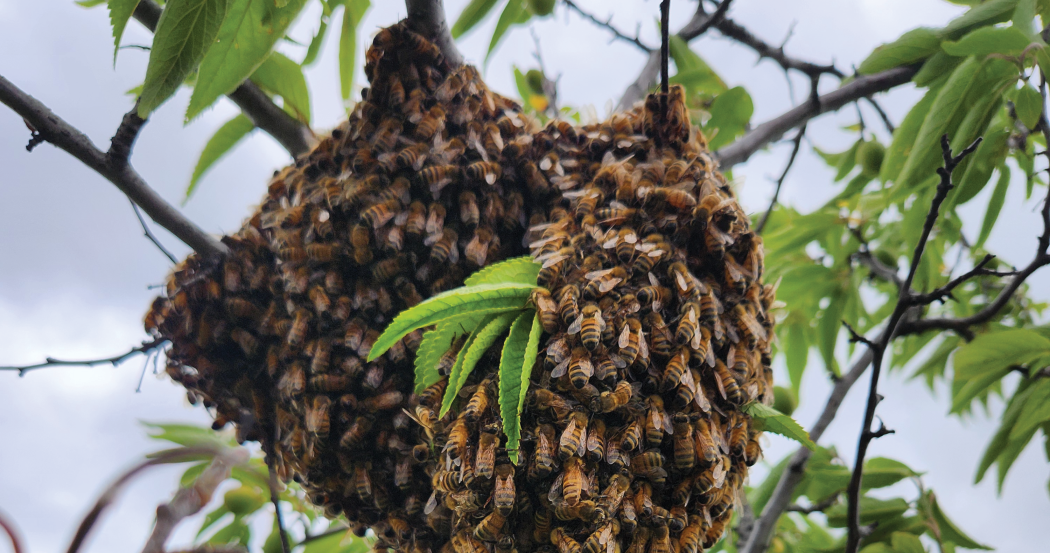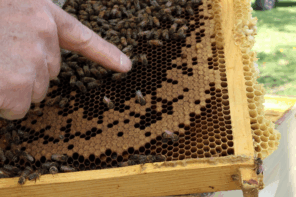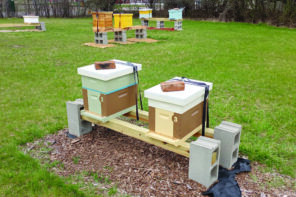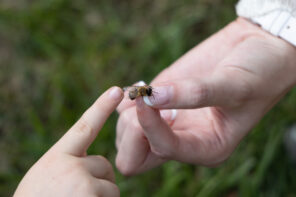Click Here if you listened. We’d love to know what you think. There is even a spot for feedback!
Read along below!
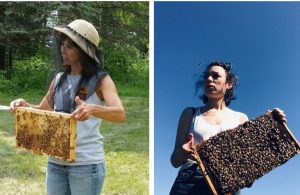
Becky Masterman earned a PhD in entomology at the University of Minnesota and is currently a host for the Beekeeping Today Podcast. Bridget Mendel joined the Bee Squad in 2013 and led the program from 2020 to 2023. Bridget holds a B.A. from Northwestern University and an M.F.A. from the University of Minnesota. Photos of Becky (left) and Bridget (right) looking for their respective hives. If you would like to contact the authors about your divides, please send an email to mindingyourbeesandcues@gmail.com.
Minding Your Bees and Cues
Divide and Prosper
By: Becky Masterman & Bridget Mendel
When it comes to doing Spring divides, beekeepers are divided. We were raised with Spring splits as a beekeeping rule, not a management exception. As beekeeping instructors, making two colonies from one was a Spring ritual, a sort of phenology of activity, just before the apples blossom. Some beekeepers might not divide their wintered colonies because they never learned the benefits. We think those beekeepers will be excited to learn the magic and bounty of split season. For others who don’t divide your bees for health reasons, we formally protest.
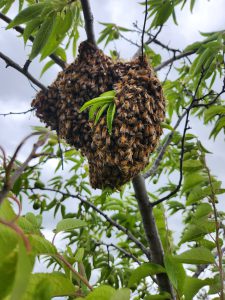
While some low hanging swarms are easy to collect, swarms may end up in cavities where they are not welcomed. Unmanaged feral colonies may also die without beekeeper help to manage parasites, pathogens, and Winter preparation. Photo credit:Rebecca Masterman
We divide colonies so the bees don’t do it for us — they typically charge a fee of ½ the bees, the queen, and possibly the honey harvest and we can’t afford it. A well-timed divide prevents an ill-timed swarm.
Added Benefits of Divides
More Bees
If you want more honey bee colonies, divides can help populate your apiaries. You can split a colony in half or take 2 or 3 divides from a large colony.
Introducing New Genetics
Whether you perform a walk-away divide and let your new queen mate with drones in your area or buy a queen from a specific genetic line or subspecies, introducing novel genetics will help you understand the impact of genes. You can choose a queen whose offspring can help you battle varroa or make more surplus honey or hopefully both!
More Money
If your apiary size is satisfactory, you can sell your splits for some extra cash. You can also decide to include your overwintered queen in the sale and use part of your proceeds to invest in a new queen.
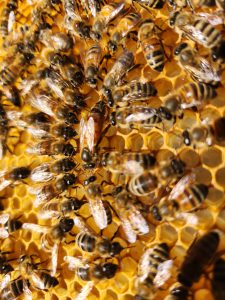
Dividing colonies is an easy way to incorporate genetic lines with qualities that support low varroa populations and high honey production. Photo credit: Rebecca Masterman
Feeling Generous
If you don’t want to keep or sell your colony divides, giving them away might be an option for you. Donating your bees to military veterans or first responders would support the growing movement of this vital group in beekeeping.
If you are selling or giving away your divides, make sure that the recipient has had some beekeeping training and is connected to a mentor. We are trying to keep these animals alive!
Brood Break
We are getting ahead of ourselves, but the interruption of colony brood production is an excellent way to slow down varroa reproduction. It can also create an excellent opportunity for mite control with no capped brood cells that offer mite mitigation protection.
Letting Bees Swarm
A research study titled How Honey Bee Colonies Survive in the Wild: Testing the Importance of Small Nests and Frequent Swarming was designed to explore the success of the Arnot Forest wild honey bee colonies (Loftus et al., 2016). The lab of Cornell University’s Dr. Thomas Seeley set up an apiary that compared small colonies that were allowed to frequently swarm with larger colonies managed for swarming. These experiments were designed to ask questions about varroa population growth, treatment free management practices and the impact of colony population size. The not surprising results demonstrated that smaller colonies not managed for swarming had lower varroa infestations, less disease and fewer deaths.
This experiment explored the strategies of wild honey bee colonies to understand the implications of how our management can change the dynamics of an animal and make it more vulnerable to parasites and pathogens. Colony populations were manipulated either by management to prevent swarming or lack of swarm prevention. While some beekeepers have interpreted this study to allow their colonies to swarm willy-nilly, the authors end their paper by pointing to splitting colonies to create a brood break like a swarm event does. Brood breaks help to slow varroa population growth. In other words, learning good management from wild colonies is not the same as not managing your hives and hoping the results are wildly successful.
If you are allowing your honey bee colonies to swarm without any type of swarm prevention practices, this strategy has unintended negative consequences. Your swarm can disrupt your neighbors’ quiet enjoyment. Being a bad beekeeper neighbor makes it difficult for the rest of us who try to maintain good relations with those near our apiaries. A swarm might be a minor disruption of bees in a neighbor’s trees. It could also be a costly disruption of bees in their eaves. Despite any attempts to collect your own swarms, sometimes the bees are going to have other ideas and go their own way. While we have met many homeowners who enjoyed the experience of a swarm of bees in their yard while it was being removed successfully, we haven’t met a homeowner yet who enjoyed paying for a colony to be removed from the walls of their homes. Bees moving into human homes could lead to increased regulation of beekeepers in urban and suburban areas.
Beekeepers who believe in the swarm as a (no) management practice have good intentions. We would argue that becoming a beekeeper means that you’ve got managed bees, not wild ones. If we understand that swarms have lower survival success, then including swarms as a practice means that you are not doing all that you can to care for the colony. As soon as it flies out of your colony, it is out of your control. We would be critical of a farmer who let their cows, sheep, pigs and turkeys leave the farm.
Finally, we don’t need to increase the feral honey bee population in the U.S. Admittedly, we didn’t make the phone calls, but we don’t think that we can find one native bee researcher who thinks that beekeepers letting their honey bee colonies set up feral nests to compete with native bees is a good idea. Let’s stay on the good side of these scientists and other native bee lovers and keep our bees in our boxes.
Unite Around Divides
We can learn from wild honey bee colonies, but managing your bees like they are wild colonies is concerning for both the bees and beekeepers. When we put bees in boxes and commit to caring for them, we need to be all in. That means limiting the swarms, not encouraging them. Swarms that get away are losses. We have all experienced swarms, but there is a difference between swarms occurring despite management and active encouragement of swarms. We hope that you find a place for splits or divides in your operation. Instead of becoming someone else’s problem, your new colonies can be a benefit to you or another beekeeper.
References and Resources
Loftus JC, Smith ML, Seeley TD (2016) How Honey Bee Colonies Survive in the Wild: Testing the Importance of Small Nests and Frequent Swarming. PLoS ONE 11(3): e0150362. doi:10.1371/ journal.pone.0150362
Beekeeping | Extension | Utah State University
https://extension.usu.edu/beekeeping/learn/behavior/splitting
Colony Division: An Easy Method to Split a Colony https://extension.psu.edu/colony-division-an-easy-method-to-split-a-colony






